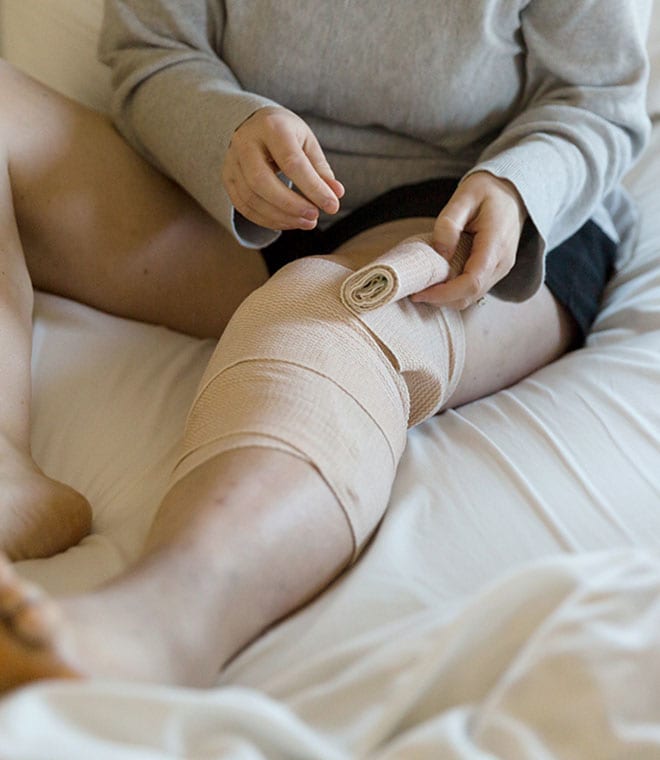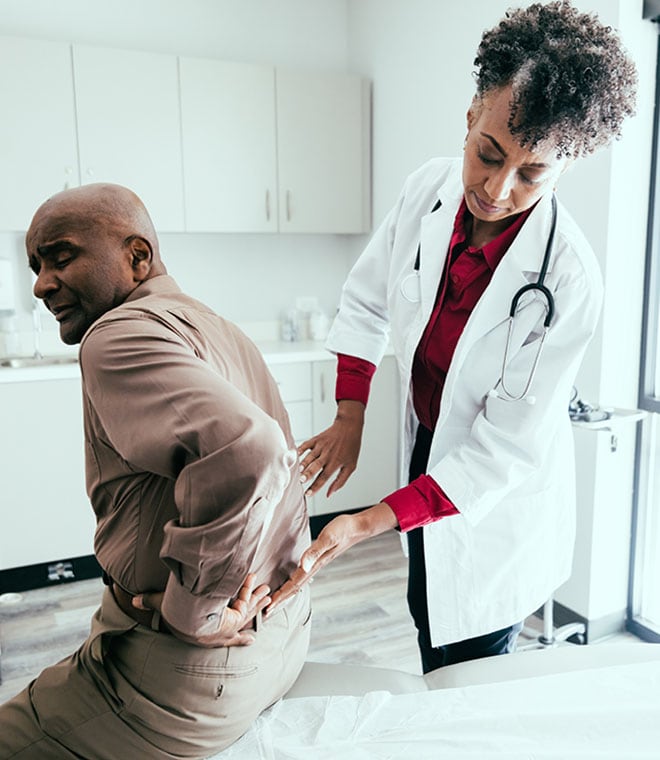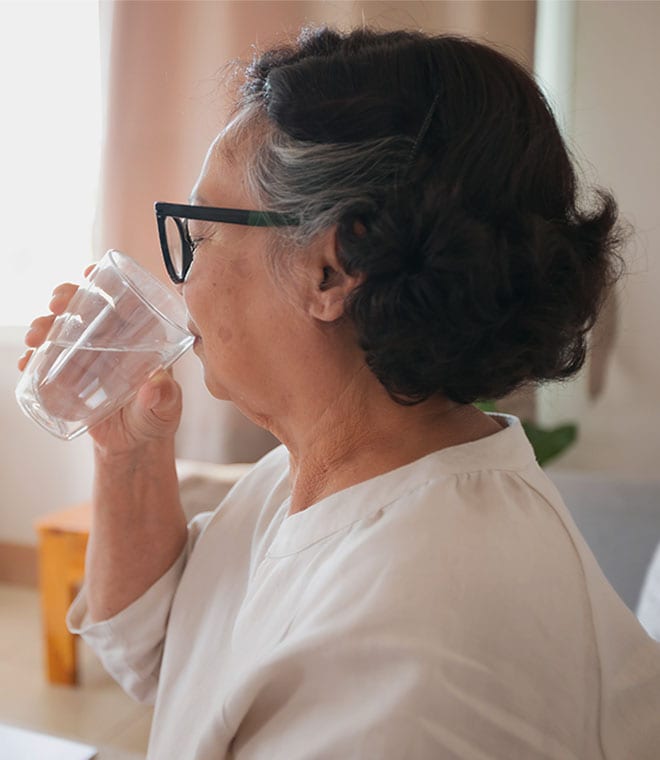Health
Back pain: Common causes and treatments
By Jean Cherry, MBA, RN May 23, 2022 • 10 min.
Do you have back pain? You are not alone.
Approximately 80% of people experience back pain during their lifetimes. Here are some common reasons why you may experience back pain and some possible ways to find relief.
What are the causes of back pain?
Lower back pain is usually due to a disruption in the way the spine, muscle and intervertebral discs fit together and move, and it’s often a result of an injury to the back. The two most common causes of back pain are sprains and strains due to overstretched and torn muscles and ligaments, and degenerative changes in the spine as people age.
Natural wear and tear on the back as you get older causes degenerative changes in the spine/back, which may also lead to back pain. Degenerative changes include disk injury from a tear, herniation (bulging), wearing away of the intervertebral disks of the spine, and spinal stenosis, where space narrows between the vertebrae, causing pressure on the spinal nerves and the spinal cord.
While most back pain is mechanical in nature, individuals may also experience pain in the back area for other reasons that are not directly connected to the structure and function of the back. Other causes include gas, pregnancy, constipation, arterial disease, vascular disease or a history of cancer.
Do digestive issues cause back pain?
Some people experience stomach and back pain simultaneously. This may happen as a result of gastritis, heartburn or acid reflux. These conditions often result in pain in the upper center portion of the abdomen and can spread to the back. Because eating can be a trigger for abdominal discomfort, some people experience back pain after eating.
There are over-the-counter digestive health remedies and prescription medications available to treat digestive issues. See your healthcare provider to determine the cause of your discomfort, and ask about treatments that are best for you.
Can gas cause back pain?
Yes. Gas pain in the stomach may be felt in the upper back, and gas pain in the abdomen may be felt in the lower back. Some gas is normal for our digestive systems, with many people passing gas up to 20 times a day. Still, too much gas can get trapped or stop moving through your digestive system, causing bloating, pain or distention of your stomach or abdomen. Abdominal distention can create a feeling of fullness and tenderness, with pain that radiates to the back. (High stress can also cause people to tense their muscles, triggering back pain and stomach bloating.)
Dietary factors known to cause excess gas include a diet of high-fiber foods, carbonated beverages, eating too fast, gum chewing, fiber supplements and sugar substitutes. Medical conditions contributing to gas pain include food allergies, constipation, stress, shifts in hormones, chronic intestinal diseases and an overgrowth of small bowel bacteria.
Most back pain and bloating symptoms are common, mild and harmless. Self-care options include beano for prevention and simethicone for expulsion. If the symptoms last longer than a week, you should see a doctor.
Does sciatica cause back pain?
Yes, sciatica can cause back pain. Sciatica is pain along the sciatic nerve, which runs from the lower back down to the hips and buttocks and then down each leg. It's very common for people to experience back pain along with hip pain. Sciatica pain can vary widely, but includes symptoms of pain, weakness and a burning, numbness or tingling sensation that may start in the lower back and extend further down the leg, through the calf and foot area and even to the toes.
Sciatica may be caused by underlying medical conditions, such as a slipped herniated disk, spinal stenosis, tumors, pelvic injury or fractures, and piriformis syndrome, a pain disorder of the narrow muscles in the buttocks. Therefore, the underlying cause must be identified and properly treated.
Healthcare providers often recommend the application of gentle ice or heat to the painful area. Over-the-counter pain relievers can also provide relief. In some cases, healthcare providers recommend physical therapy to strengthen muscles and increase flexibility.
Can urinary tract infections cause back pain?
Urinary tract infections (UTI), also known as bladder infections, may cause symptoms of back pain. Along with the well-known frequent urge to urinate, burning sensation when urinating, and urine that smells bad or looks cloudy or reddish, some individuals may also experience pain in the back or sides below the ribs. If left untreated, a urinary tract infection (UTI) can spread to one or both kidneys, resulting in kidney and back pain. It's important to seek immediate medical attention if you are experiencing symptoms of a kidney infection, which include:
- Fever
- Back, side (flank), groin or abdominal pain
- Nausea
- Frequent urination, burning or pain when urinating or a continued feeling that you need to urinate, but you can’t.
What causes back pain during pregnancy, menstruation and ovulation?
Lower back pain is a common problem among pregnant people. As pregnancy progresses, lower back pain can be a result of changes in posture, pelvic changes, alterations in weight, along with weakness in muscles or ligaments becoming loose and affecting various joints. You may ease your back pain during pregnancy by wearing low-heeled shoes with arch supports, sitting in chairs with good back support, sleeping with pillows between the knees, applying hot or cold compresses or massaging pressure to the area that hurts. Pregnancy-induced back pain often resolves after the baby is born.
Back pain associated with menstruation and ovulation is caused by hormonal changes. Over-the-counter pain relievers are often recommended by healthcare professionals in order to manage the pain. Applying gentle heat can also be helpful.
Is lower back pain a sign of pregnancy?
Yes, lower back pain is a common sign of pregnancy, associated with changing hormonal levels.
Does interrupted sleep cause back pain?
If back pain is interfering with your sleep, be sure to see a healthcare provider to determine the cause. Some people experience back pain from a mattress. It's important to find a comfortable mattress that reduces back discomfort so that a good night's sleep is possible.
What treatments help common back pain?
Conventional treatments, including using multiple interventions at the same time, are:
Hot or cold packs: Heat and cold both help to ease pain and reduce inflammation. Even though they don't resolve low back injury quickly, they provide comfort and allow for greater mobility.
Activity: Limit bed rest. Instead, stretch and resume regular activity as soon as you can. Bed rest has been shown in studies to increase back pain and can lead to blood clots in the legs, less muscle tone and even depression.
Physical therapy strengthens core muscle, allowing for better back support, greater mobility and better posture. Therapists can also help you with your gait and other potential causes of back pain.
Medications: Some OTC medications that help relieve back pain include aspirin, acetaminophen, ibuprofen and naproxen sodium. Prescriptions include opioids, which are addictive and should be used under careful supervision of a healthcare provider for a short duration of time, and COX-2 inhibitors (such as Celebrex), which treat pain and inflammation. Anticonvulsants, antidepressants and counter-irritants may help some people for specific back pain causes.
Additional therapies: Traction, acupuncture, nerve blocks, transcutaneous electrical nerve stimulations (TENS) and epidural steroid injections for thoracic back pain may be used. Behavioral options include biofeedback, meditation, music, distraction and cognitive behavioral therapy (CBT).
Surgery should be considered only after other treatments have failed but may be necessary for serious musculoskeletal injuries and nerve compression. In some cases, surgeries may not be successful, and flexibility may be reduced.
The best strategy for keeping a back healthy is completing low-impact exercises for 30 minutes per day, especially those that strengthen the lower back and abdominal muscles, as well as maintaining good posture when standing, sitting and lifting.
Talk to your pharmacist or healthcare provider if you have questions about medications or various therapies for your back pain.
Clinically reviewed and updated by Nancy Kupka, PhD, RN, May 2022.
Sources:
1. https://orthoinfo.aaos.org/globalassets/pdfs/about-your-back.pdf
2. https://www.uptodate.com/contents/clinical-manifestations-and-diagnosis-of-early-pregnancy
3. https://www.uptodate.com/contents/treatment-of-acute-low-back-pain?source=history_widget
4. https://www.niddk.nih.gov/health-information/digestive-diseases/constipation/symptoms-causes
5. https://www.ninds.nih.gov/Disorders/Patient-Caregiver-Education/Fact-Sheets/Low-Back-Pain-Fact-Sheet
6. https://medlineplus.gov/ency/article/003120.htm
7. https://www.uptodate.com/contents/evaluation-of-low-back-pain-in-adults


